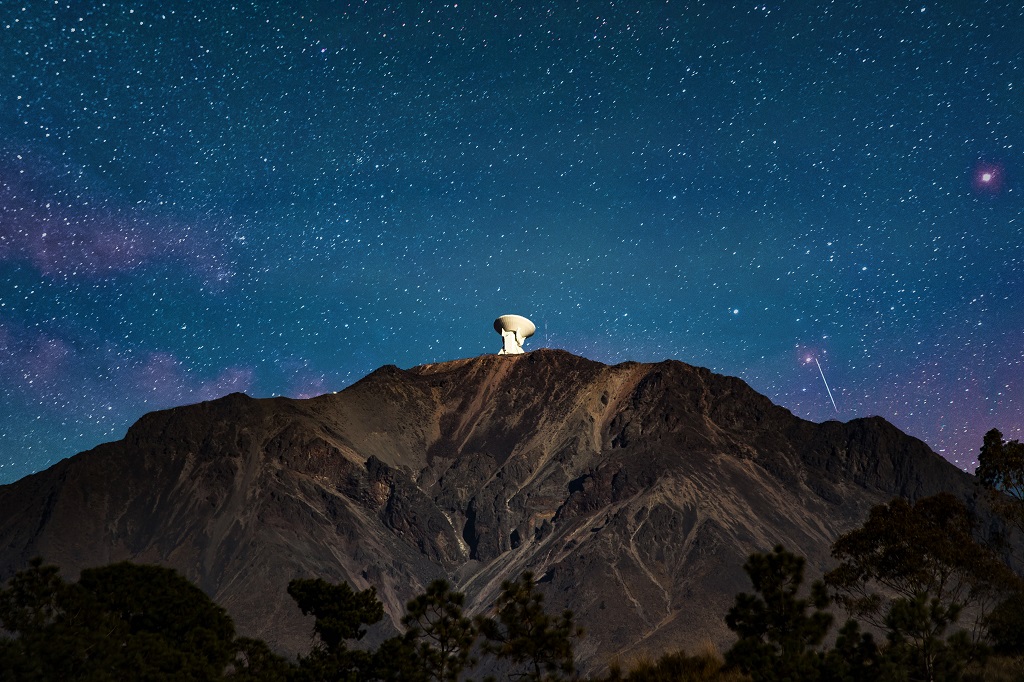Why is quantum Internet being built in space, and who is already implementing such projects
It is believed that satellite quantum networks are the most efficient way to deploy global cryptographic key distribution systems. We tell who is already working in this direction, and talk about the potential problems of this approach. / Unsplash / NASA
/ Unsplash / NASAWhat are quantum networks?
A quantum network is a data transmission system whose operation obeys the laws of quantum mechanics. The exchange of information takes place using qubits - polarized photons transmitted via an optical communication channel. Technology is an important component of cryptographic key distribution systems . In such a system, the sender and receiver have an open optical communication channel and pass each other a key for encrypting packets.Connection security is provided by the fundamental laws of physics. Photons are very “fragile” and are destroyed when read. For this reason, it is almost impossible to “eavesdrop” on quantum networks - an attempt to MITM attack is immediately obvious to the receiving side.And here is space
A number of engineers are convinced that satellite quantum networks are the most convenient and economically feasible way to build global cryptographic key distribution systems. But first, let's talk about another promising technology - quantum repeaters.Photons are absorbed by the medium due to interference, so it is difficult to transmit them over long distances (about 100 km). The task of quantum repeaters is to prevent losses in the transfer of particles through optical fiber. Today, such systems are developed by Dutch engineers. They are building a 10 km test network between The Hague and the city of Delft. Also in this area are Japanese physicists.But quantum repeaters have a number of disadvantages. They allow you to connect only two points between which fiber-optic cable is stretched. By transmitting the data in a chain, the repeaters decode them and then encode them again - this approach can lead to leaks in the event of a compromised node. The manufacture of such devices also requires expensive magnets and rare minerals. At the same time, quantum repeaters are at the very early stages of development and there is no talk of their practical application on a large scale.About what else we write in a blog on Habré
 / Unsplash / Shahadat RahmanTherefore, some engineers are working on alternative approaches to building quantum networks and cryptographic key distribution systems based on them. A group of physicists from universities in the USA, Japan and China considered that the most effective method would be to scan a group of satellites in orbit that transmit photons to the ground via lasers. In their scientific work, engineers give calculations and simulation results, which showed that the best option is to deploy 400 satellites at an altitude of 3 thousand kilometers ( p . 10 ).This approach will allow you to send keys up to 7.5 thousand kilometers - for example, from London to Mumbai. For quantum repeaters, such indicators are not yet available - they need to be setat a distance of 200 km from each other.
/ Unsplash / Shahadat RahmanTherefore, some engineers are working on alternative approaches to building quantum networks and cryptographic key distribution systems based on them. A group of physicists from universities in the USA, Japan and China considered that the most effective method would be to scan a group of satellites in orbit that transmit photons to the ground via lasers. In their scientific work, engineers give calculations and simulation results, which showed that the best option is to deploy 400 satellites at an altitude of 3 thousand kilometers ( p . 10 ).This approach will allow you to send keys up to 7.5 thousand kilometers - for example, from London to Mumbai. For quantum repeaters, such indicators are not yet available - they need to be setat a distance of 200 km from each other.Who is already implementing space projects
In 2016, Chinese engineers launched a quantum communications satellite. A year later, they managed to transfer the qubit to a distance of over 1200 km. The device hung in a 500-km orbit and transmitted photons using a laser to a receiving station in Tibet. In 2018, the technology has already been tested in practice. Chinese scientists held a 75-minute video conference with colleagues from the Austrian Academy of Sciences on a secure channel. / Unsplash / Kevin QuezadaPhysicists in Germany are also involved in space quantum projects. Back in 2017, they installedthat for the transmission and teleportation of "entangled" photons, you can use conventional communication satellites. At about the same time, experts from the Max Planck Society for Scientific Research initiated the development of a satellite imaged for quantum cryptography. The plans are to design a special on-board computer for signal processing.
/ Unsplash / Kevin QuezadaPhysicists in Germany are also involved in space quantum projects. Back in 2017, they installedthat for the transmission and teleportation of "entangled" photons, you can use conventional communication satellites. At about the same time, experts from the Max Planck Society for Scientific Research initiated the development of a satellite imaged for quantum cryptography. The plans are to design a special on-board computer for signal processing.Who opposes
A large number of specialized quantum satellites can create additional inconvenience. It is believed that the first Starlink satellites launched by SpaceX already interfere with Earth observations. It also refers to a potential overabundance of debris in Earth orbit. The US Federal Trade Commission (FTC) proposed the development of a number of documents that will allow this problem to be resolved, but most likely this issue cannot be resolved only by paper standards. We need new systems to clean the orbit and tools to track debris and satellites in space.Materials about networks and protocols in the VAS Experts blog:
Source: https://habr.com/ru/post/undefined/
All Articles